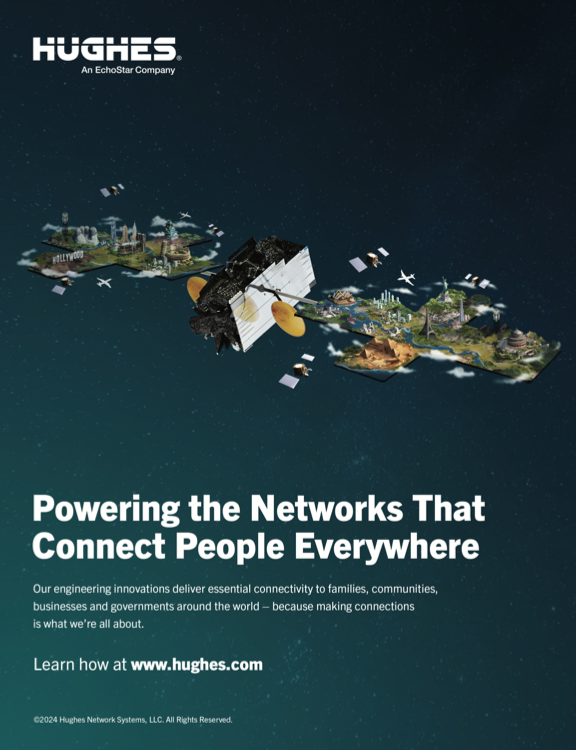Constant connectivity is demanded anywhere on the planet...How can that be made possible?
In the era of unparalleled, global communications, staying connected is more critical than ever before, no matter where you are located. Whether you’re navigating urban jungles, or exploring ‘off-grid’ and away from the urban infrastructure, maintaining a strong and stable data connection can be a formidable task.

The power of hybrid networking is at and how this technology can help people and machines that are constantly on the move to stay connected in even the most rugged and remote environments.
Communications-On-The-Move (COTM) can present many challenges, especially when there is a need to operate over large, diverse, geographical areas, or across the global theater.
Urban canyons in major cities dominated by dense concrete structures can render satellite links inoperative, whilst cellular coverage can be limited outside the main conurbations, even in the most developed economies. Add to this challenge is the exponential demand for connectivity of new and emerging technologies, such as drones, Machine-to-Machine (M2M) functionality as well as autonomous vehicles and transport — it’s not difficult to see how the orthodoxy of today’s conventional infrastructure — and business models — are constantly being challenged. The rapid, continuous, and ubiquitous transfer of data today is permeating every aspect of modern life, dominated by countless connectivity-dependent services.
Defence, space, connected and autonomous craft, emergency services, telehealth, Artificial Intelligence (AI) and Machine-Learning (ML), and a host of other applications, demand connectivity, but such as to be an ‘intelligent connection’, and this demand is opening up considerable opportunities for telecommunications, OEMs and other technology-led businesses to transform their operations and consumer facing services.
In the Aviation industry, aided by AI, power-by-the-hour, automation and security are reshaping the entire industry landscape, including the sector’s value chain and interdependent business models.
IoT and Industry 4.0 are transforming the productivity of OEMs as well as maintenance and repair operations (MROs), ushering in the emergence of new paradigms, from Infrastructure-as-a Service (IaaS), to such as Aircraft-as-a- Service (AaaS) and smart aircraft and mobility, forcing players to scale up and/or hasten increasing horizontal consolidation of the sectors.
In the Automotive sector, connected vehicles and the shift to electric and autonomous cars heralds a fully digitalized world, with colossal implications for its ecosystem and industrial base. Cars are increasingly becoming pre-configured for incremental upgrades via Over-The-Air (OTA) systems throughout the lifecycle of a vehicle; witness how Tesla — in barely a decade — has led the revolution toward “software-defined vehicles.”
Tesla has almost independently set the new standard in automotives, where the value of a vehicle’s software potentially exceeds that of the installed hardware, by evolving cars from, essentially, electro-mechanical platforms to intelligent, upgradeable and secure systems.

Being able to integrate existing with future connectivity services is a powerful proposition that can enable more efficient systems, workflows, and peopleThere are many underlying communication technologies — and even more service providers — willing to pick up this baton. However, in spite of recent advances in telecommunications technology — from 5G cellular services and disruptive, low- cost, Low Earth Orbit (LEO) satellite services — there is no single network service that can address the exponential demand for seamless connectivity on the move. Nor is there any provider that can offer a single comprehensive solution that can address coverage, bandwidth, reliability and, most importantly, cost.
The concept of agnostically making use of any network, based on location, cost or quality of service, should dramatically reduce the impact of the problem, and yet awareness and application of ‘bonding’ technology is nowhere near where it needs to be as machines and people demand ever faster ‘always-on’ connectivity.
Away from conventional cellular networks, fixed satellite architecture has been a primary broadcast medium for mass markets and geographic reach, and only providing rapid deployment in emergency situations and in diverse remote area applications, including those of natural disasters.
Satellite COTM and Communications-On-The-Pause (COTP) has harnessed ever evolving, smart antennae designs and has stimulated the use of multi- channel systems to improve resilience and to optimize performance. Yet, due to premium priced infrastructure, satellite communication (SATCOM) can be perceived to be quite expensive when compared to other types of broadband that offer similar, or faster, speeds.
The capacity for selective routing to satellite networks, alongside the ability to combine this with the power of all other available networks, lies at the heart of hybrid connectivity, and the many advantages this technology can offer.
At the core of hybrid is SD-WAN, a technology that uses software- defined networking concepts to distribute network traffic across a wide area network (WAN). This architecture creates a virtual overlay that bonds underlying private or public WAN connections, such as Multiprotocol Label Switching (MPLS), internet broadband, fiber, wireless or LTE — as a result, hybrid SD-WAN networking can agnostically combine and transition between these networks.
In truly hybrid — or ‘heterogeneous’ — networks, multiple network technologies must, therefore, bond seamlessly work together, actively sharing the load and resources, by combining, and bringing together a variety of bearers from cellular and LTE, to satellite and Wi-Fi into a single ‘pipe.’ In this way, a hybrid network is able to deliver a faster and, crucially, more reliable service.
In practice, a hybrid platform goes several stages further than that, adapting to a range of other variables, depending upon each bearer’s performance and any other environmental conditions affecting it at any one moment in time, in order to optimise performance and reduce costs, such as restricting the use expensive or inefficient bearers. In a similar way to the least cost routing of voice calls, parameters can be set to allow for the most cost-effective bearer to be used if the pipe is good enough; for instance, cellular can take preference over satellite if the performance is adequate, thereby reducing the costs of always using satellite.
The same principle must be applied to the handling of Quality of Service (QoS), to ensure the performance of critical applications in the face of limited network capacity, rapid variations in bandwidth and latency. A more in-depth analysis of hybrid connectivity and its impact on markets, far beyond just the telecommunications industry, can be found in Livewire Digital’s recently published white paper — The Future is Hybrid Connectivity.
Livewire Digital’s research and development of hybrid communications started in 2012 as part of a situational awareness project for the European Space Agency (ESA).
To achieve full hybrid connectivity, RazorLink was developed as an industry- first SDN solution that seamlessly and dynamically bonds any number of bearers, from satellite, cellular, Point-to-Point (P2P) radio, Wi-Fi and terrestrial services in line with user-defined objectives and prevailing conditions. For instance, continuous and fast Internet connectivity can deliver significant benefits to rail operators and passengers. Designed to meet the challenges presented by a fast-moving train traveling through different areas of network coverage, smart networking enables a dynamic connection to various operators using a range of underlying communication technologies such as 3G, 4G, 5G, Wi-Fi and satellite.
Likewise, the bonding and optimization of the communications path can allow drones to deliver live, low-latency video and advanced 3D world sensing and mapping data. This technology is already being deployed with great success with police in the United Kingdom (UK) and first responder markets.
Meanwhile, in the Maritime market segments, where most ocean-going vessels access SATCOM for telephone and data services, there is a growing need for ‘always on’ connected services for engineer management and security applications. Third-party products can assist to some degree by allowing a vessel to select a particular service; however, only limited services can be used at any time and each switchover necessitates many, on-board applications to re-establish their links with the shore — with more services, a higher demand for bandwidth, and with a growing significant pressure on cost, this is no longer a viable approach.
To address these challenges, true hybrid connectivity, improving the performance of applications over high latency satellite, poor quality cellular coverage, and intermittent Wi-Fi links is the path to the future. On land, and especially in urban communities, the evolution of Connected Autonomous Vehicles (CAVs) is ushering in a new era of transportation, promising safer roads, efficient mobility, and unparalleled convenience. At the heart of this transformation lies a critical technological need — the seamless integration of multiple network technologies — a true Hybrid Network.
With CAVs, a truly robust communication infrastructure is a necessity; it’s the lifeline that ensures these vehicles navigate, operate, and communicate flawlessly across varied terrains and conditions. Imagine a scenario where a train, guided by well-defined tracks, faces challenges in maintaining consistent connectivity...now, magnify this complexity many times over for autonomous vehicles, crossing borders, and encountering a wide variety of infrastructure and signals.
As automotive autonomy advances, the roadmap for CAVs demands innovation and adaptability. Manufacturers must design flexible architectures that accommodate increasing bandwidths and actively support distributed hybrid network structures.

As demand for reliable connectivity in global mobility markets, such as aviation — manned and unmanned — and maritime, continues to grow, peak-time capacity and multi-dimensional networks that can draw upon the correct options at the correct time are more important than ever. Global mobility markets continue to grow in importance, and at a rapid pace, moving from tactical to strategic investment decisions.
Ubiquitous connectivity on the move is set to become the default minimum for an increasingly interconnected world, in business, government, for those on the move, and in the home. To date, hybrid connectivity solutions have been based on switching or failover using classic routing techniques that operate well over fixed infrastructure.
Applying this technique to connectivity on the move, where the availability and characteristics of networks change rapidly, resulting in intermittent connectivity, poor performance and difficulty in scaling, will no longer be acceptable, and no longer accepted by consumers and regulators.
A technology that can seamlessly combine multiple networks, such as 4G, 5G, Wi-Fi and LEO SATCOM, into one fast, secure and highly resilient service is already present today and is a ‘true hybrid’ solution and is being developed in the UK to address the needs of a rapidly changing world.
livewiredigital.com

Tristan Wood
Author Tristan Wood is the founder of Livewire Digital.
For more than 30 years Livewire Digital has been pioneering connectivity solutions for clients in diverse and often challenging settings where access to video and other data is mission-critical. Inventors and innovators in network technologies, Livewire Digital’s software team, based in the UK, have brought ground-breaking solutions to market which have been transformational in fields as diverse as television can be used at any time and each switchover necessitates many, on-board broadcasting, defence, satellite communications, telemedicine and cellular network operations. Founded by Tristan Wood in 1991, Livewire Digital has assembled over the ensuing years an unrivalled team of specialists with unparalleled knowledge and expertise in delivering the fastest most resilient connectivity solutions to suit the most demanding environments. This was the first company to introduce commercial, narrow-band video via mobile satellite terminals and developed a comprehensive, hybrid-WAN & WAN- optimization solution for the maritime and land mobile markets. Livewire Digital is a leading edge across the globe when designing SDN solutions that operate over cellular, terrestrial and satellite services.



